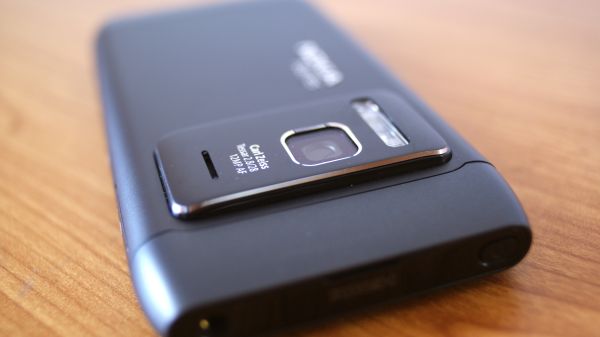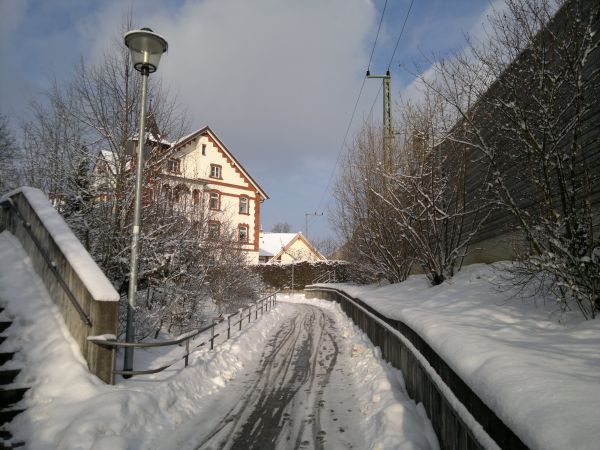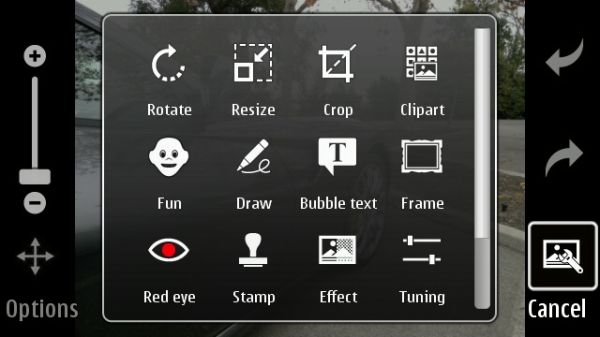Nokia N8 Review: Nokia's New Flagship
by Mithun Chandrasekhar on January 12, 2011 1:00 AM EST- Posted in
- Smartphones
- Nokia
- N8
- Symbian
- Mobile
The N8’s 12MP centerpiece
As I had briefly mentioned earlier, the Nokia N8 has what is probably the best camera to make home in a mobile phone. And Nokia is making no bones in letting people know about this. While Apple may talk about letting in more photons with a backside illuminated sensor, Nokia has actually gone ahead and done something about it—both with the optics and sensor size. At the heart of the N8’s camera is a 1/1.83” sensor which is in fact larger than most point and shoot cameras (which often carry sensors ranging from 1/2.3 – 1/2.5” in size) that are currently available. While a large sensor can’t do much by itself, Carl Zeiss has provided a decent 28mm equivalent lens that makes good of the sensor, given the tight confines and dimensional restrictions of a mobile phone. In fact, much of the N8’s physical profile is dictated by that optical system.
Just to drive home the point as to how serious it is about the N8 as an imaging device, Nokia has equipped the phone with a real xenon flash (and an AF-assist lamp in the same housing) along with an active neutral density filter that automatically slides in place if you were to try and take pictures with a lot of bright light in it. This combined with features such as face detection and video stabilization (not image) make the N8 a reasonably good replacement to most entry-level point and shoot cameras currently available. The N8 could pull off pretty good shots without much issue in all but the poorest of lighting conditions. In poorly-lit scenarios, the N8 succumbs to its camera phone roots and produces visibly noisy pictures that lack detail. Pulling down the ISO manually and using a tripod would help, but this IS a phone after all.
I haven’t been able to pull up a guide number for the xenon flash, but suffice to say that it is an order of magnitude better than the LED/dual-LED flash found in most phones. Also, since the N8 lacks a motorized lens, it has a digital-only zoom which Nokia has consciously restricted to 2x for still photos and 3x for videos for the sake of maintaining image quality. The average size of a 4000x3000 pixel (12MP) image taken by the N8 is about 2.4MB which means it is compressed a fair bit. When set to “Close Up” mode the N8 can focus on objects as close as 3”.
Shots with the N8’s brilliant 12MP camera. The gallery has more camera shots.
Speaking of video, the N8 can record 720p video at 25fps with stereo sound. The N8 has 2 mics; one next to the camera module and another on the front of the phone. In test, the N8 could capture pretty decent audio even in moderately noisy and windy environments. It looks like the positioning of the mics and the noise cancellation algorithms together are doing a decent job of cutting out the background noise. In use, the N8 captured 720p video at an average bit rate of about 10 Mbps in the H.264/AVC format. The N8 makes use of something called an active hyperfocal system to maintain focus between about 60cm to infinity, without having to use a continuous focusing system. To describe this in a little more detail without diving too deep, the hyperfocal length of a lens is a measure of some distance at which, if the lens is focused, everything from a particular point (60cm in case of the N8) to infinity will be in complete focus. In the N8, the camera and software adjust the position of the lens if needed, to maintain this hyperfocal length and hence the “active” moniker. Because of this, the N8 can make do without hefty auto-focusing motors and deliver good focusing performance.
Bench Video
Demo Video
The camera interface itself is pretty straightforward and easy to use. You can easily change the captured image resolution, white balance, color tone, flash, scene mode and ISO options. There are quite a few still photo and video editing options available on the phone and the N8 seems to do a reasonably quick job of post processing. The one thing that I found quite annoying, was having to make all edits in one go on the N8. You cannot “save” a project as such; you have to make all your edits at once and save the file.
In-phone editing options on the N8
The N8 does not support panorama shots out of the box and I found this a bit surprising. Only when I casually dug through the Ovi Store did I find the “Panorama” app by Nokia.
Why this isn’t included from the get go or even pointed to by a link somewhere beats me. Either way, the panorama app does its job without any issues, although I must say I had to read the help section to try and understand how to get it working; not the most straightforward implementation for taking panorama shots. As with most camera phones now-a-days, the N8 also supports geo-tagging photos and videos. At the end of it, the one thing that’s blatantly clear is that the camera on the N8 is not a checkbox feature. It really is a well-engineered piece of hardware that Nokia seems to have integrated very well with the N8, instead of just tacking it on as an after-thought.








































119 Comments
View All Comments
tipoo - Wednesday, January 12, 2011 - link
Yeah, apart from the camera I don't see much good here. Battery life below middle of the road, browser performance at the bottom of the pack, inferior OS, app store lags behind iOS and Android, etc. An equivalent camera on an Android phone or the iPhone 5 would be nice.vol7ron - Wednesday, January 12, 2011 - link
With no optical zoom, I'm not even sure I need a 12MP camera. It's nice, but digital zoom is worthless.To me, the best part about the phone is the xenon flash.
Exodite - Wednesday, January 12, 2011 - link
Isn't that a bit counter-intuitive?With digital zoom you'd ideally want more pixels to avoid losing to much detail when you use it.
vol7ron - Saturday, January 15, 2011 - link
You'd want more MP, but it's pointless, because even when it tries to interpolate the pixels, there is still distortion, even when you scale it down. Some sort of optical zoom is def more ideal.GSJ - Wednesday, January 12, 2011 - link
What could have been if it ran Android.........warisz00r - Wednesday, January 12, 2011 - link
Optimus One performace for Galaxy S price?xype - Wednesday, January 12, 2011 - link
"And with one such update promised for the N8 sometime in Q1 2011, it may be the device to recommend, after the update."Oh, _please_. That's almost Android-level optimism, here. It might get an update at some point, the update might be good, it might make everything right and better.
Have a look at how many Android phones are running 2.3, how many 2.1 phones got 2.2 updates, how many people applied those and combine with how long it took Google to actually get halfway where iOS is with its ecosystem and you'll get an idea about what Nokia can _eventually_ accomplish if they get _everything_ right.
In short: no, it won't be the device to recommend.
Samus - Wednesday, January 12, 2011 - link
You're comparing Nokia to Google. The difference in phone software experience is over two decades apart.Nokia updates and supports their products exceptionally well, probably better than any other phone manufacture.
warisz00r - Wednesday, January 12, 2011 - link
lolno they dont.Suffering E72 user here.
Samus - Thursday, January 13, 2011 - link
Suffering how? I had an E73 Mode for a few months before I plucked down $400 for the N8-00, and the only pain with it was getting outbound emails to work correctly for my business email...gmail and hotmail worked flawlessly. After tweaking everything, the phone worked flawlessly and I was satisfied enough to buy another Nokia.If you have an E72 with AT&T, that might explain many of your problems because they really screwed up the OS. T-mobile is traditionally "hands-off" with core system software and most ATT people on the forums talk about just unlocking a factory E71 or E73 from T-mobile to use on ATT. They work a lot better.